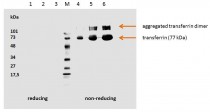ARG63114
anti-Transferrin antibody [HTF-14]
anti-Transferrin antibody [HTF-14] for ELISA,Functional study,ICC/IF,IHC-Formalin-fixed paraffin-embedded sections,Radioimmunoassay,Western blot and Human,Pig,Rabbit
Cell Biology and Cellular Response antibody; Controls and Markers antibody; Signaling Transduction antibody
Overview
| Product Description | Mouse Monoclonal antibody [HTF-14] recognizes Transferrin |
|---|---|
| Tested Reactivity | Hu, Pig, Rb |
| Species Does Not React With | Bov, Dog, Hrs, Sheep |
| Tested Application | ELISA, FuncSt, ICC/IF, IHC-P, RIA, WB |
| Specificity | The clone HTF-14 recognizes an epitope located in the N-terminal domain of human serum transferrin, a 77 kDa single polypeptide chain glycoprotein (member of the iron binding family of proteins). It is synthesised in the liver and consists of two domains each having a high affinity reversible binding site for Fe3+. |
| Host | Mouse |
| Clonality | Monoclonal |
| Clone | HTF-14 |
| Isotype | IgG1 |
| Target Name | Transferrin |
| Antigen Species | Pig |
| Immunogen | Purified porcine transferrin. |
| Conjugation | Un-conjugated |
| Alternate Names | Beta-1 metal-binding globulin; Siderophilin; Transferrin; PRO1557; TFQTL1; Serotransferrin; PRO2086 |
Application Instructions
| Application Suggestion |
|
||||||||||||||
|---|---|---|---|---|---|---|---|---|---|---|---|---|---|---|---|
| Application Note | WB: Under non-reducing condition. Functional studies: The clone HTF-14 blocks binding of transferrin to the receptor. * The dilutions indicate recommended starting dilutions and the optimal dilutions or concentrations should be determined by the scientist. |
||||||||||||||
| Positive Control | IHC-P: Placenta |
Properties
| Form | Liquid |
|---|---|
| Purification | Purified from ascites by precipitation methods and ion exchange chromatography. |
| Purity | > 95% (by SDS-PAGE) |
| Buffer | PBS (pH 7.4) and 15 mM Sodium azide |
| Preservative | 15 mM Sodium azide |
| Concentration | 1 mg/ml |
| Storage Instruction | For continuous use, store undiluted antibody at 2-8°C for up to a week. For long-term storage, aliquot and store at -20°C or below. Storage in frost free freezers is not recommended. Avoid repeated freeze/thaw cycles. Suggest spin the vial prior to opening. The antibody solution should be gently mixed before use. |
| Note | For laboratory research only, not for drug, diagnostic or other use. |
Bioinformation
| Database Links | |
|---|---|
| Background | Transferrin is a monomeric glycoprotein of approximately 77 kDa, which serves as an iron-transporter. In normal plasma, transferrin has a concentration of 25-50 µmol / liter, and is usually about one-third saturated with iron, thus providing a large buffering capacity in case of an acute increase in plasma iron levels. Cells take up transferrin-iron complexes (holotransferrin) using transferrin receptor dimers. Upon binding of holotransferrin, the receptor is internalized by clathrin-mediated endocytosis. Acidification of endosomes by vesicular membrane proton pumps leads to dissociation of iron ions, whereas transferrin (apotransferrin) remains associated with its receptor (CD71) and recycles to the cell surface, where apotransferrin is released upon exposure to normal pH. Internalization of labeled transferrin thus represents an usefull approach to study endocytosis. Serum concentration rises in iron deficiency and pregnancy and falls in iron overload, infection and inflammatory conditions. Iron/transferrin complex is essential in haemoglobin synthesis and for certain types of cell division. |
| Research Area | Cell Biology and Cellular Response antibody; Controls and Markers antibody; Signaling Transduction antibody |
| Calculated MW | 77 kDa |
Images (2) Click the Picture to Zoom In
-
ARG63114 anti-Transferrin antibody [HTF-14] WB image
Western blot: Human Transferrin with different lodings. 1) 5 µg, 2) 3 µg, 3) 1 µg, M) marker, 4) 1 µg, 5) 3 µg, and 6) 5 µg stained with ARG63114 anti-Transferrin antibody [HTF-14].
Lane 1-3: reducing condition. Lane 4-6: non-reduring condition. -
ARG63114 anti-Transferrin antibody [HTF-14] IHC-P image
Immunohistochemistry: Paraffin-embedded Human placenta tissue stained with ARG63114 anti-Transferrin antibody [HTF-14].
Clone References









